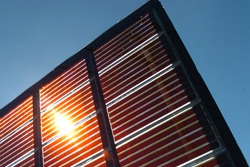New solar facility in Ohio to produce next generation of PV
 Thanks to a partnership with the Ohio Third Frontier Fund, Dyesol Inc.’s (OTCBB:DYSOY) new DyeTec Solar facility in Toledo, Ohio, will soon start producing prototypes of what it calls the third generation of solar technology, dye-sensitized solar cells (DSC).
Thanks to a partnership with the Ohio Third Frontier Fund, Dyesol Inc.’s (OTCBB:DYSOY) new DyeTec Solar facility in Toledo, Ohio, will soon start producing prototypes of what it calls the third generation of solar technology, dye-sensitized solar cells (DSC).
The solar cells are being developed for applications including glass-based building-integrated photovoltaics (BIPV), building-applied photovoltaics (BAPV) and automotive-integrated photovoltaic (AIPV) products.
“Our objective is to turn buildings from being just buildings and becoming power plants,” said Dyesol CEO Mark Thomas.
The technologies Dyesol is developing can be applied to surfaces. So the metal siding of a building or its windows could be coated with DSCs and effectively become a power source for the building.
“Our technology offers a very strong advantage over other technologies as it doesn’t need direct sunlight,” he said.
Dyesol’s DSC technology consists of an electrolyte, a layer of titania (a pigment used in white paints and tooth paste) and ruthenium dye. The technology can basically be printed onto a surface, like metal or glass, Thomas said.
When light strikes the dye, it excites electrons, which are absorbed by the titania where they’re converted to an electric current. Since the solar device is literally printed onto a surface, it’s less expensive to manufacture than silicon photovoltaics.
Dyesol is positioning itself as a manufacturer of DCS technologies that will allow downstream customers to build their own photovoltaic glasses and metals, according to Thomas.
“Our primary involvement with the joint venture is a materials supplier,” he said.
As such, Dyesol provided the DyeTec Solar facility with the fabrication equipment.
“The equipment will be used to develop prototype DSC-based BIPV glass products and related equipment sets, laying the foundation for future high volume manufacturing capability of glass-based BIPV.” Dyesol said in a press release.
The site could also make AIPV glass prototypes. Such devices could be used to charge vehicle batteries or power fans or air conditioning for vehicles, according to Thomas. It could be incorporated into windshields and other glass in a vehicle, he said.
BIPV or BAPV products with Dyesol technology could be on the market as soon as 2013, according to Thomas.
“With the metal products, we’re beyond the research and development phase,” he said. “We’re in the ramp up phase.”
Glass-based products won’t likely make a commercial appearance until 2014 or 2015.
Image courtesy of Dyesol.



